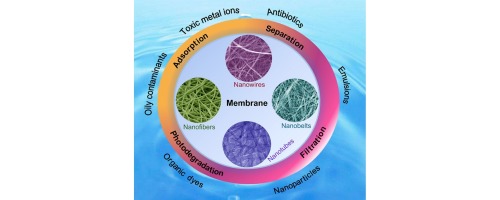当前位置:
X-MOL 学术
›
Nano Today
›
论文详情
Our official English website, www.x-mol.net, welcomes your
feedback! (Note: you will need to create a separate account there.)
One-dimensional nanomaterial-assembled macroscopic membranes for water treatment
Nano Today ( IF 13.2 ) Pub Date : 2017-12-01 , DOI: 10.1016/j.nantod.2017.10.012 Li Yu , Shuangchen Ruan , Xintong Xu , Rujia Zou , Junqing Hu
Nano Today ( IF 13.2 ) Pub Date : 2017-12-01 , DOI: 10.1016/j.nantod.2017.10.012 Li Yu , Shuangchen Ruan , Xintong Xu , Rujia Zou , Junqing Hu

|
Abstract With the worldwide exponential development of population and industrialization, water pollution has become a serious issue for flora, fauna and human beings. The increasing concerns on environment sustainability require one to develop advanced materials and technologies for high-performance water treatment. Nanomaterials, exhibiting advantages of high specific surface areas and controlled architectures thereof have been vastly developed for improving the treatment speed, efficiency and selectivity. Membranes are favored materials for water decontamination due to their solute selectivity, handling robustness, and easy operational process without extra energy input. In this scenario, the combination of nanomaterials and membrane technology during water cleaning is required for both scientific research and real-world applications. One-dimensional (1D) nanomaterials-based membranes (e.g., self-assembled nanowires, nanobelts/ribbons, nanotubes, nanofibers) possessing interconnected open pore structures and large surface areas, were widely used to remove oily contaminants, toxic metal ions, emulsions, nanoparticles, small organic molecules such as antibiotics and dyes from water. This review focuses on the water treatment by using these nanomaterial-based membranes, which will be categorized based on their functionalities, i.e., adsorption, separation, filtration and photocatalytic degradation. In each section, representative studies and recent advances will be described. Further, future perspectives and challenges are summarized and put forward for developing multifunctional nanomaterial-based membranes for environmental remediation.
中文翻译:

用于水处理的一维纳米材料组装宏观膜
摘要 随着世界范围内人口和工业化的指数级发展,水污染已成为植物、动物和人类面临的严重问题。对环境可持续性的日益关注要求人们开发用于高性能水处理的先进材料和技术。纳米材料具有高比表面积和可控结构的优点,已被广泛开发用于提高处理速度、效率和选择性。膜由于其溶质选择性、处理稳定性和易于操作的过程而无需额外能量输入,因此成为水净化的首选材料。在这种情况下,科学研究和实际应用都需要在水净化过程中将纳米材料和膜技术相结合。基于一维 (1D) 纳米材料的膜(例如,自组装纳米线、纳米带/带、纳米管、纳米纤维)具有互连的开孔结构和大表面积,被广泛用于去除油性污染物、有毒金属离子、乳液、纳米粒子、有机小分子,如抗生素和水中的染料。本综述着重于使用这些基于纳米材料的膜进行水处理,这些膜将根据其功能进行分类,即吸附、分离、过滤和光催化降解。在每一节中,将描述代表性研究和最新进展。此外,总结并提出了开发用于环境修复的多功能纳米材料基膜的未来前景和挑战。例如,自组装纳米线、纳米带/带、纳米管、纳米纤维)具有互连的开孔结构和大表面积,被广泛用于去除油性污染物、有毒金属离子、乳液、纳米颗粒、小有机分子如抗生素和染料从水。本综述着重于使用这些基于纳米材料的膜进行水处理,这些膜将根据其功能进行分类,即吸附、分离、过滤和光催化降解。在每一节中,将描述代表性研究和最新进展。此外,总结并提出了开发用于环境修复的多功能纳米材料基膜的未来前景和挑战。例如,自组装纳米线、纳米带/带、纳米管、纳米纤维)具有互连的开孔结构和大表面积,被广泛用于去除油性污染物、有毒金属离子、乳液、纳米颗粒、小有机分子如抗生素和染料从水。本综述着重于使用这些基于纳米材料的膜进行水处理,这些膜将根据其功能进行分类,即吸附、分离、过滤和光催化降解。在每一节中,将描述代表性研究和最新进展。此外,总结并提出了开发用于环境修复的多功能纳米材料基膜的未来前景和挑战。纳米纤维)具有相互连接的开孔结构和大表面积,被广泛用于去除水中的油性污染物、有毒金属离子、乳液、纳米颗粒、有机小分子(如抗生素和染料)。本综述着重于使用这些基于纳米材料的膜进行水处理,这些膜将根据其功能进行分类,即吸附、分离、过滤和光催化降解。在每一节中,将描述代表性研究和最新进展。此外,总结并提出了开发用于环境修复的多功能纳米材料基膜的未来前景和挑战。纳米纤维)具有相互连接的开孔结构和大表面积,被广泛用于去除水中的油性污染物、有毒金属离子、乳液、纳米颗粒、有机小分子(如抗生素和染料)。本综述着重于使用这些基于纳米材料的膜进行水处理,这些膜将根据其功能进行分类,即吸附、分离、过滤和光催化降解。在每一节中,将描述代表性研究和最新进展。此外,总结并提出了开发用于环境修复的多功能纳米材料基膜的未来前景和挑战。从水中提取小有机分子,如抗生素和染料。本综述着重于使用这些基于纳米材料的膜进行水处理,这些膜将根据其功能进行分类,即吸附、分离、过滤和光催化降解。在每一节中,将描述代表性研究和最新进展。此外,总结并提出了开发用于环境修复的多功能纳米材料基膜的未来前景和挑战。从水中提取小有机分子,如抗生素和染料。本综述着重于使用这些基于纳米材料的膜进行水处理,这些膜将根据其功能进行分类,即吸附、分离、过滤和光催化降解。在每一节中,将描述代表性研究和最新进展。此外,总结并提出了开发用于环境修复的多功能纳米材料基膜的未来前景和挑战。将描述代表性研究和最新进展。此外,总结并提出了开发用于环境修复的多功能纳米材料基膜的未来前景和挑战。将描述代表性研究和最新进展。此外,总结并提出了开发用于环境修复的多功能纳米材料基膜的未来前景和挑战。
更新日期:2017-12-01
中文翻译:

用于水处理的一维纳米材料组装宏观膜
摘要 随着世界范围内人口和工业化的指数级发展,水污染已成为植物、动物和人类面临的严重问题。对环境可持续性的日益关注要求人们开发用于高性能水处理的先进材料和技术。纳米材料具有高比表面积和可控结构的优点,已被广泛开发用于提高处理速度、效率和选择性。膜由于其溶质选择性、处理稳定性和易于操作的过程而无需额外能量输入,因此成为水净化的首选材料。在这种情况下,科学研究和实际应用都需要在水净化过程中将纳米材料和膜技术相结合。基于一维 (1D) 纳米材料的膜(例如,自组装纳米线、纳米带/带、纳米管、纳米纤维)具有互连的开孔结构和大表面积,被广泛用于去除油性污染物、有毒金属离子、乳液、纳米粒子、有机小分子,如抗生素和水中的染料。本综述着重于使用这些基于纳米材料的膜进行水处理,这些膜将根据其功能进行分类,即吸附、分离、过滤和光催化降解。在每一节中,将描述代表性研究和最新进展。此外,总结并提出了开发用于环境修复的多功能纳米材料基膜的未来前景和挑战。例如,自组装纳米线、纳米带/带、纳米管、纳米纤维)具有互连的开孔结构和大表面积,被广泛用于去除油性污染物、有毒金属离子、乳液、纳米颗粒、小有机分子如抗生素和染料从水。本综述着重于使用这些基于纳米材料的膜进行水处理,这些膜将根据其功能进行分类,即吸附、分离、过滤和光催化降解。在每一节中,将描述代表性研究和最新进展。此外,总结并提出了开发用于环境修复的多功能纳米材料基膜的未来前景和挑战。例如,自组装纳米线、纳米带/带、纳米管、纳米纤维)具有互连的开孔结构和大表面积,被广泛用于去除油性污染物、有毒金属离子、乳液、纳米颗粒、小有机分子如抗生素和染料从水。本综述着重于使用这些基于纳米材料的膜进行水处理,这些膜将根据其功能进行分类,即吸附、分离、过滤和光催化降解。在每一节中,将描述代表性研究和最新进展。此外,总结并提出了开发用于环境修复的多功能纳米材料基膜的未来前景和挑战。纳米纤维)具有相互连接的开孔结构和大表面积,被广泛用于去除水中的油性污染物、有毒金属离子、乳液、纳米颗粒、有机小分子(如抗生素和染料)。本综述着重于使用这些基于纳米材料的膜进行水处理,这些膜将根据其功能进行分类,即吸附、分离、过滤和光催化降解。在每一节中,将描述代表性研究和最新进展。此外,总结并提出了开发用于环境修复的多功能纳米材料基膜的未来前景和挑战。纳米纤维)具有相互连接的开孔结构和大表面积,被广泛用于去除水中的油性污染物、有毒金属离子、乳液、纳米颗粒、有机小分子(如抗生素和染料)。本综述着重于使用这些基于纳米材料的膜进行水处理,这些膜将根据其功能进行分类,即吸附、分离、过滤和光催化降解。在每一节中,将描述代表性研究和最新进展。此外,总结并提出了开发用于环境修复的多功能纳米材料基膜的未来前景和挑战。从水中提取小有机分子,如抗生素和染料。本综述着重于使用这些基于纳米材料的膜进行水处理,这些膜将根据其功能进行分类,即吸附、分离、过滤和光催化降解。在每一节中,将描述代表性研究和最新进展。此外,总结并提出了开发用于环境修复的多功能纳米材料基膜的未来前景和挑战。从水中提取小有机分子,如抗生素和染料。本综述着重于使用这些基于纳米材料的膜进行水处理,这些膜将根据其功能进行分类,即吸附、分离、过滤和光催化降解。在每一节中,将描述代表性研究和最新进展。此外,总结并提出了开发用于环境修复的多功能纳米材料基膜的未来前景和挑战。将描述代表性研究和最新进展。此外,总结并提出了开发用于环境修复的多功能纳米材料基膜的未来前景和挑战。将描述代表性研究和最新进展。此外,总结并提出了开发用于环境修复的多功能纳米材料基膜的未来前景和挑战。











































 京公网安备 11010802027423号
京公网安备 11010802027423号